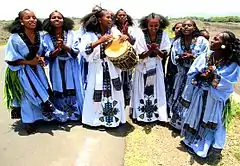Ashenda
Ashenda (ኣሸንዳ) is a festival celebrated in northern parts of Ethiopian communities (typically in Tigray and Amhara Region), and Tigre ethnicity in Eritrea. The holiday started as a religious one, but evolved to a cultural one celebrated by girls of all religious backgrounds. It commemorates the heavenly ascension of the Virgin Mary following her Dormition, a feast called Filseta. It is typically celebrated between 16 and 26 August every year.[1] Its length varies from three days to one month depending on the locale, being celebrated over a longer duration in rural areas and a shorter one in urban areas.
| Ashenda | |
|---|---|
 Group of girls with Habesha kemis celebrating Ashenda | |
| Official name | Ashenda |
| Also called | Girls' Day |
| Observed by |
|
| Type | Festival |
| Begins | 16 August |
| Ends | 26 August |
| Date | After ending of Filseta feast |
| Frequency | Annual |
| Related to | Filseta |
Celebration
Prior to the celebration, groups of girls make preparations for the holiday by buying new clothes, visiting hairdressers, preparing drums and harvesting the distinctive 'Ashenda' grass (which will be tied around their waist for the celebration).
On the first day, the Ashenda girls gather together and make the journey to their local Church of St. Mary (or any other Orthodox Tewahedo Church in the community), playing music and dancing. They then go around the entire village, expressing their thanks to each household in the community. The Ashenda girls spend around 20 minutes at each house, entertaining families and themselves, before being bid farewell usually with gifts of money, food or drink. After the door to door celebrations, the girls find a suitable field in or near the village, spending between a day to a week dancing and playing in the field while passing men are urged to provide gifts of money.
All money and gifts collected over the course of the celebration are then donated to a charity, the Church or other events.
Name
The Ashenda holiday is named after the long, thin 'Ashenda' grass which girls tie to hang down from their waists in a fashionable pattern. The Ashenda grass has come to symbolise the cultural festival, as dancing girls move their waists causing the leaves to shake in an eye-catching manner.
References
- "Children Delight in Tales on Wheels". Inter Press Service. 20 September 2010. Archived from the original on 24 November 2010. Retrieved 7 August 2014.
Further reading
- Yohannes, Gebregeorgis (2010). Tirhas Celebrates Ashenda: An Ethiopian Girls' Festival. Sololia Publishing. ISBN 9781883701024.